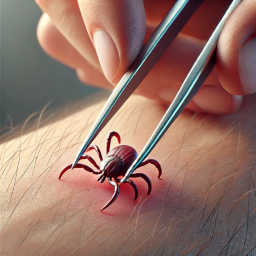
Despite all precautions, it can still happen and you find a tick embedded in your skin.
Don’t panic! Here’s the step-by-step on handling a tick bite:
Time is critical – the sooner you remove it, the lower the chance of disease transmission. Use a pair of fine-tipped tweezers (every household should have one designated for ticks). Grasp the tick as close to the skin’s surface as possible, basically grabbing its head or mouthparts (cdc.gov). Pull upwards with steady, even pressure (cdc.gov). Don’t twist or jerk, as that can break off the mouthparts in your skin. Just a firm, steady pull straight out. It might take a few seconds of steady pressure (ticks can be stubborn).
After removal, clean your skin with soap and water and/or an antiseptic like rubbing alcohol or iodine scrub. This helps prevent any local infection (tick bites can sometimes get a bit red or irritated just from the puncture).
You want to be sure it’s dead and gone. Good methods: drop it in a small container of alcohol which will kill it, or put it in a sealed bag or tape it to a piece of paper (ticks stuck in tape can’t escape). You can then throw it out. Flushing down the toilet works too. Optional: If you want, you can save the tick (in alcohol or a sealed bag) in case you develop illness and want it identified or tested. Labs can test ticks for pathogens, though this is usually not necessary; doctors treat based on your symptoms, not just tick testing. But some people feel better knowing what the tick carried.
After a tick bite, pay attention to your body over the next days to weeks. Not every tick carries disease, so don’t assume you’ll get sick. But be alert. Common early signs of tick-borne illness include fever, chills, headache, fatigue, muscle/joint aches, and rash (like the erythema migrans bullseye rash for Lyme(dph.illinois.gov) or spotted rashes for RMSF). If you get a flu-like illness in the summer (when flu is not around) or a strange rash, see a doctor and mention the tick bite. For Lyme disease, a red expanding rash at the bite site (appearing 3-30 days after) is a telltale sign (dph.illinois.gov). For others, unexplained fever or sickness within a couple weeks of bite is the cue.
You don’t need to run to the doctor for every tick bite. But you should consider it if:
It’s normal for the bite area to have a small red bump or slight redness immediately after the tick is removed (similar to a mosquito bite). This doesn’t mean infection. If the red area grows larger over days (especially if it expands >2 inches and forms a bullseye), that’s likely a Lyme rash (dph.illinois.gov), see a doctor. If it just stays small or even gets a little itchy but doesn’t expand, it’s probably just irritation. Keep it clean, maybe apply a little antibiotic ointment. If it develops pus or significant pain (signs of a local skin infection), get it checked, though that’s uncommon.
It’s helpful to note the date you removed the tick and roughly how long you think it was attached, and what the tick looked like (was it a deer tick? dog tick? small as a sesame seed or larger?). This info can be handy if you do get sick later, for your doctor’s detective work. You might even take a clear photo of the tick before disposal for ID purposes.
Not every tick bite leads to disease. In fact, even in high-risk Lyme areas, only a minority of bites (maybe a few percent) result in Lyme transmission, especially if the tick is removed promptly. By following the above steps, you’ve done everything in your power. Many of us in tick country have been bitten and are just fine thanks to quick removal and watching for signs.
If you have removed a tick, reward yourself with a treat (ice cream for bravery?) and continue to be tick-safe out there.